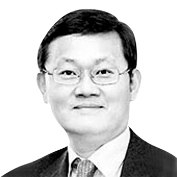A year after the pandemic

The author, former chief economist at the Asian Development Bank and a senior adviser for international economic affairs to former President Lee Myung-bak, is a professor of economics at Korea University.
April was the cruelest month in New York in 2020. More than 10,000 cases of coronavirus were counted daily, and on April 16, 3,215 people died from the disease. The streets were empty, and ambulance sirens woke me at night. The apartment where I stayed had a notice about a funeral. And yet hardly anyone wore a mask — other than Asians.
In the state of New York, with a population of 20 million, more than 2 million people have tested positive, and 52,000 have died. Average daily positive cases are still 4,000, and 50 people die a day. But the atmosphere has changed. Streets are crowded and restaurants have increased their serving capacity to 50 percent and operate till midnight. 45 percent of the city’s residents have received at least a first dose of the vaccine, and 32 percent have completed the course. There are hopes that people will be able to return to their pre-Covid routines. The IMF predicts that the U.S. economy will bounce back with 6.4 percent growth thanks to vaccinations.
Lately, Korea has around 700 positive cases daily and the total number of cases is 120,000. We have suffered 1,820 deaths. The situation is not comparable to the U.S. Korea’s early Covid-19 response has gotten high marks from the world. There have been many discussions on how Korea could minimize damages. Having experienced epidemics like SARS and MERS, Korea successfully minimized positive cases and deaths without complete lockdowns through prompt testing, aggressive contact tracing and isolation of suspected cases. People wore masks and obeyed social distancing requirements.
The outstanding medical system Korea has built played an important role. Korea has 12.3 beds per 1,000 people, far more than 2.8 in the U.S. As Korean citizens all have health insurance, they do not hesitate to seek medical help when feeling unwell. Many Americans do not have health insurance, and even those that have insurance are reluctant to visit doctors because of heavy out-of-pocket deductibles. In America, when you are treated for Covid-19, hospitalization costs an average of $60,000, half of which the patient has to pay. In Korea, patients do not have to pay much of the cost thanks to the national health insurance.
Korea established a universal health care system long ago. In 1977, companies with more than 500 employees were required to offer health insurance, and with continued expansion, a universal health insurance system that covers the entire nation was completed in 1989. Whether run by conservative or liberal governments, the system was continuously updated to accommodate economic development and people’s demands for social security.
The liberal Moon Jae-in administration is being criticized for not procuring enough vaccines after its successful handling of the pandemic in the early stages. As a result, many people have reduced trust in the government. Various rumors only serve to confuse the public. Last week, there was talk of a Korea-U.S. vaccine “swap” and a review of possible use of Russia’s Sputnik V vaccine. Fortunately, the government announced an additional contract for Pfizer vaccines and a plan to vaccinate 23 percent of the population with first doses and 7 percent with second doses by the end of June to help attain “herd immunity.” That is supposed to be achieved with the inoculation of 70 percent of the 50 million population by November. But most people cannot begin to guess when they can get their jabs, take off their masks and start engaging in normal economic activities.
The Moon administration has gained a lot of political benefits from its successful pandemic control. According to a Gallup poll, Moon’s approval rating was 71 percent in the first week of May 2020 with 85 percent of respondents viewing the government’s Covid-19 response positively. But now, 49 percent approve the government’s response to Covid-19 while over 43 percent do not. As a result, Moon’s approval rating has fallen to as low as 31 percent. The government’s response to Covid-19 will determine his popularity in the future.
After suffering through the pandemic, Koreans await the day when the government defeats Covid-19. It must return to its initial mindset, get its head out of the clouds, review its vaccine policy and devise comprehensive ―and systematic ―plans. As past administrations created the universal health insurance system and continued improving it, the Moon government must establish an excellent disease control system, help develop native vaccines and nurture the medical industry for the future. With one year left in office, Moon must prioritize vaccinations and economic recovery as the top items on his agenda and address long-term and short-term strategies for the country.
Translation by the Korea JoongAng Daily staff.










with the Korea JoongAng Daily
To write comments, please log in to one of the accounts.
Standards Board Policy (0/250자)